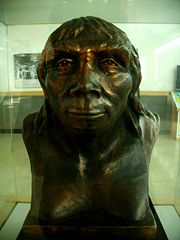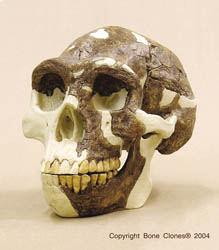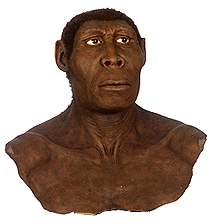Mysterious Peking Man Again
Posted by: Loren Coleman on March 12th, 2009

The media has turned to a Gigantopithecus and Homo erectus expert (who has said some things about Yeti) for his views on the breaking “Peking Man” news.
Today, various news sites will overwhelm you with the information that the famed “Peking Man” fossils (really some of which are of females) are maybe 200,000 years older than previously thought, according to a new dating study.
The revised date could change, we are being told, the timeline and number of migrations of the Homo erectus species out of Africa and into Asia. It also suggests that Peking Man endured glacial climates.
The first fossils of the species were found on Java, Indonesia, in 1892 by Eugène Dubois, and thus called “Java Man” (originally Pithecanthropus erectus).

Nearly 30 years later, in 1923-27, more Homo erectus fossils were found thousands of miles away during excavations of the Zhoukoudian (Chou K’ou-tien) cave system just outside of Beijing, China, which was called Peking back then, and thus they are called the “Peking Man” fossils. They were initially classified as Sinanthropus pekinensis and Pithecanthropus pekinensis.
Today, Pithecanthropus erectus, Pithecanthropus pekinensis, and Sinanthropus pekinensis are considered examples of Homo erectus.

The original reconstruction of Peking Man was prepared by Dr. F. Weidenreich and Mrs. Lucille Swan in 1937 from the fossil remains of several different individuals found in the caves at Zhoukoudian, China. The Bone Clones replica of the Peking Man is easily obtainable today.
But where are the originals?
One of the most enduring mysteries of paleoanthropology is “What happened to the Peking Man?”
Fossils of Peking Man were placed in the safe at the Cenozoic Research Laboratory of the Peking Union Medical College. Eventually, in November 1941, secretary Hu Chengzi packed up the fossils so they could be sent to USA for safekeeping until the end of the war. They vanished en route to the port city of Qinghuangdao. They were probably in possession of a group of US marines whom the Japanese captured when the war began between Japan and the USA.
Various parties have tried to locate the fossils, but so far they have been without result. In 1972, a US financier Christopher Janus promised a $5,000 (USD) reward for the missing skulls; one woman contacted him, asking for $500,000 (USD) but she later vanished. In July 2005, the Chinese government founded a committee to find the bones to coincide with the 60th anniversary of the end of World War II. They remain missing.
There are various theories of what might have happened, including a theory that the bones sank with the Japanese ship Awa Maru in 1945.

Today’s widely publicized new study, funded by the National Natural Science Foundation of China and Wenner-Gren Foundation, is published in the March 12 issue of the journal Nature. Guanjun Shen at Nanjing Normal University, China, is the lead author of the study.
But the guy the media interviewed for most of their stories today is paleoanthropologist Russell L. Ciochon of the University of Iowa in Iowa City, who was not involved in the new study.
Russell L. Ciochon is the anthropologist who is responsible for most of the contemporary writings on Gigantopithecus, which some think is the best candidate for Bigfoot/Sasquatch, or for others, the Yeti.
This “Peking Man” study is of interest to scientists because the populations of the species that lived in Africa are “implicated in the ancestry of modern humans,” said Ciochon.
These glacial cycles didn’t involve mounds of snow and ice as one might think, rather it was “just a colder, drier period,” Ciochon told LiveScience.
Homo erectus is “a species that had legs,” Ciochon said, referring to the distances traveled. “Aside from Homo sapiens, it’s the most widespread hominin species.”
Ciochon said that the new date for the Zhoukoudian fossils lends credence to the idea that there could have been more than one migration route.
“Maybe there could have been two dispersals,” he said. One route could have extended along the coast of Asia to Java, and another through the interior of Eurasia to Zhoukoudian and the surrounding areas.
Was the climate more Arctic-like than previously thought, because of these new earlier dates? Could have Peking Man been more hair-covered that originally conceived? What more intensive interactions did Homo erectus have with Gigantopitchecus, due to this new revised timeline? Is the fossil form Homo erectus the ancestor of the island-sized little Homo floresiensis?
Like everything else with the Peking Man, we are left with more questions than answers, once again.
About Loren Coleman
Loren Coleman is one of the world’s leading cryptozoologists, some say “the” leading living cryptozoologist. Certainly, he is acknowledged as the current living American researcher and writer who has most popularized cryptozoology in the late 20th and early 21st centuries.
Starting his fieldwork and investigations in 1960, after traveling and trekking extensively in pursuit of cryptozoological mysteries, Coleman began writing to share his experiences in 1969. An honorary member of Ivan T. Sanderson’s Society for the Investigation of the Unexplained in the 1970s, Coleman has been bestowed with similar honorary memberships of the North Idaho College Cryptozoology Club in 1983, and in subsequent years, that of the British Columbia Scientific Cryptozoology Club, CryptoSafari International, and other international organizations. He was also a Life Member and Benefactor of the International Society of Cryptozoology (now-defunct).
Loren Coleman’s daily blog, as a member of the Cryptomundo Team, served as an ongoing avenue of communication for the ever-growing body of cryptozoo news from 2005 through 2013. He returned as an infrequent contributor beginning Halloween week of 2015.
Coleman is the founder in 2003, and current director of the International Cryptozoology Museum in Portland, Maine.










Everyone would be amazed at the stuff that gets lost in the museum world. Around 1968, a mastodon was found while excavating a road near Miami Missouri. The bones were packed in plaster and shipped to the University of Illinois and others sent to a lab for carbon date testing. No one in Missouri, Illinois or the lab knows what happened to all this stuff. All of it – Poof! Into thin air.
An incised tablet from the same area dating from the Oneota culture also disappeared. Probably one of the most striking pieces of artwork from that culture in our locality. Casts were made of all the images on the tablet. Poof! The original vanished into thin air. University records say it was returned to the family that found it, but no receipts and no one in the family knows about it.
So for the loss of bones in a place like China in a war time situation, it would have been highly unusual if they would have gotten out and made their way into a permanent collection. A good bet – the bottom of the sea or Japanese troops didn’t give a plugged nickel for them and simply tossed them aside when they captured the Marines.
If you check out the Wikipedia entry for Zhoukoudian Caves you’ll find some excellent information about the site, including some very nice pics of how the actual sites and the general area looks and descriptions of the local geology, which looks to my eye, a lot like the cave country of Kentucky and the appalachians, not to suggest there’s H. erectus in them thar hills, but rather that the geological context is itself something of a selective force in the case of these few dozen individuals’ remains.
Homo erectus had fire. That is a proven way to stay warm. Fur not required.
From the records of the recovery of “Peking Man” it appears to have been a pastiche of human and monkey bones from a site where humans butchered and ate monkeys. Java Man was a composite of at least two individuals, from two rather different strata, separated in horizontal space along a river bank by a good distance. That isn’t science, that is either hoaxing like the Piltdown Man composite of human and orangutan bones, or at best, wishful thinking, as happens a lot with the Leakey and Johansson expeditions.
However, other Homo erectus skeletons have been found in various places, even though the more famous first two really don’t count.
How much do we know of the range of Gigantopithecus? Or where they lived? I don’t doubt that there was interaction, but how extensive it was would depend on the range of Gigantopithecus.
Homo erectus features are not absent from modern human physiognomy. I’ve seen with my own two eyes that this is the case. Below the neck, so far as I know, there is no difference.